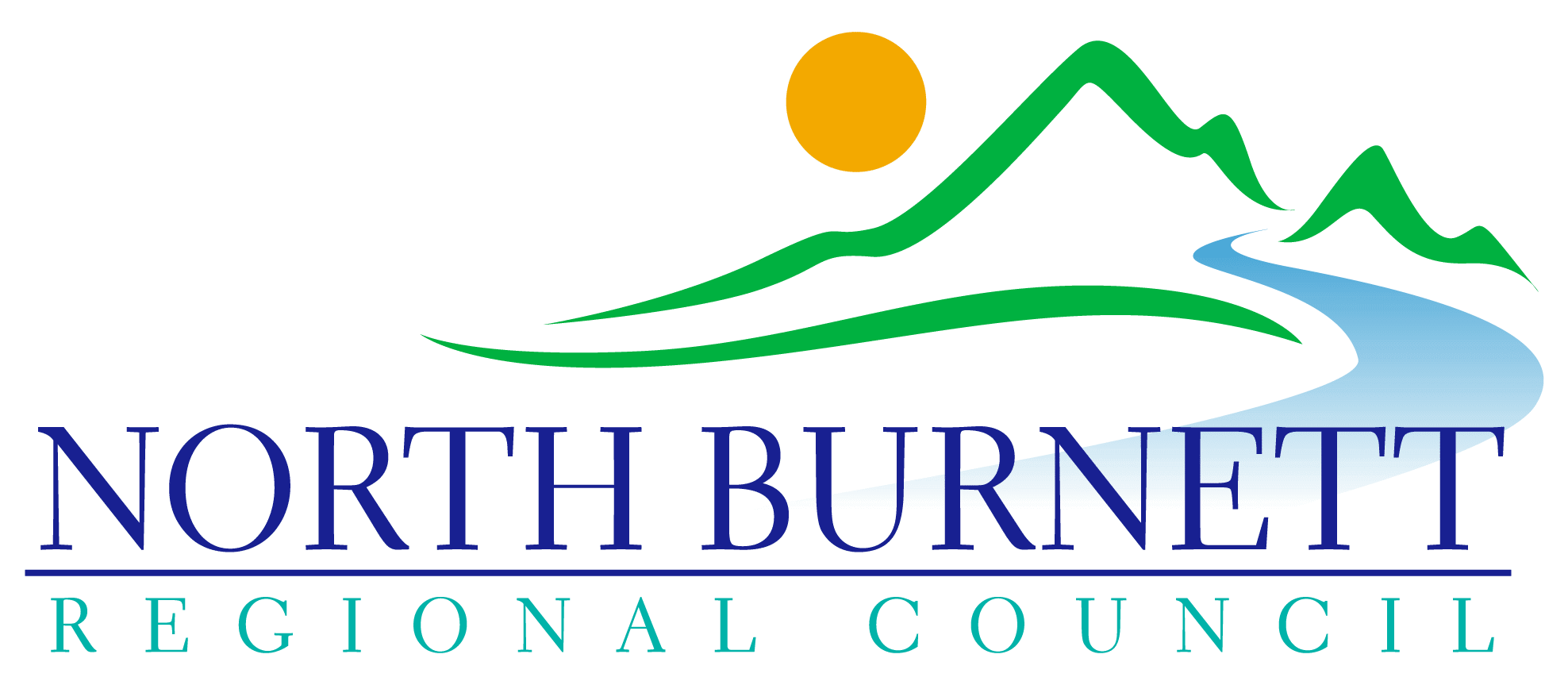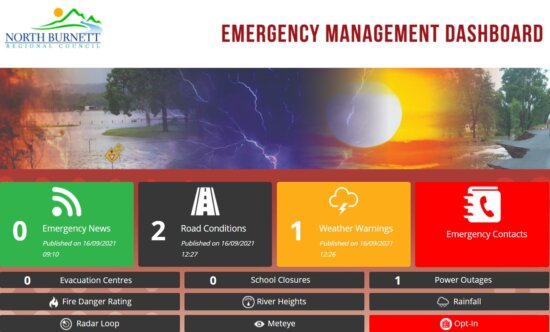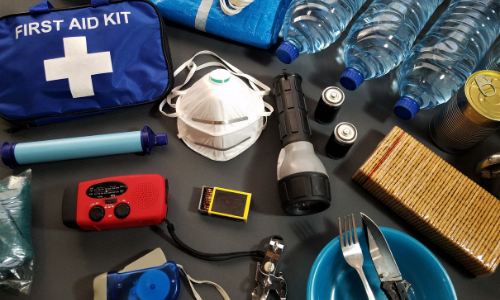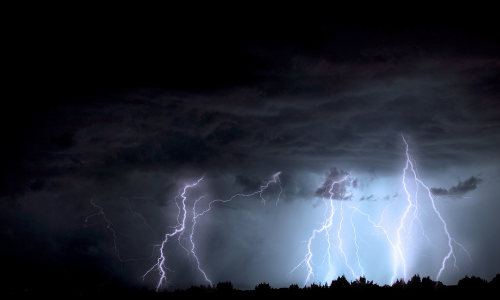Disaster Management

During a Disaster
In the event of a disaster or emergency, it is important to stay calm. Follow your prepared emergency plan and, if possible, visit our Disaster Dashboard or tune into local radio to stay informed and promptly follow instructions from authorities.
Stay Informed
Emergency Dashboard
Council has developed a public-facing platform that acts as a one-stop shop for essential information about the local area in times of disaster. By providing easy access to up-to-date information (e.g. road closures, weather updates, school closures, emergency warnings, etc.), this dashboard provides situational awareness to the North Burnett Local Disaster Management Group (LDMG) and general community and serves as a tool for critical decision-making for the LDMG.
Visit the Emergency Dashboard at emergency.northburnett.qld.gov.au
Radio Stations
ABC Wide Bay is the region’s Emergency Radio Station. It is vital that you tune in, in the event of an emergency.
- 855 kHz AM Wide Bay & Burnett
- 100.1 mHz FM Wide Bay
Warnings and Alerts
Council utilises a suite of communication methods to issue warnings and alerts to the community, including:
- Disaster Dashboard;
- social media;
- radio and TV updates;
- media releases;
- face-to-face (i.e. door knocking); and,
- Emergency Alerts
Emergency Alert System
Emergency Alert is the national telephone-based emergency warning system capable of sending warning messages to fixed line telephones (i.e. landlines) and mobile phones.
The Emergency Alert system provides emergency service organisations and our Local Disaster Management Group with an effective way to warn communities in the event of an emergency, such as bushfire and extreme weather events. For more information, please visit the Australian Government Emergency Alert website.
Stay Informed
| Service | Number |
|---|---|
| All Emergency Calls (including Police, Fire, Ambulance and for reporting fallen powerlines) |
000 |
| North Burnett Local Disaster Management Group Local Disaster Coordination Centre (only activated during declared emergencies) |
1300 696 272 |
| State Emergency Service (SES) Tarping/Branches down |
13 25 00 |
| Queensland Police Service – Police Link (Non life-threatening calls) | 13 14 44 |
| Queensland Ambulance Service (Non life-threatening calls) | 13 12 33 |
| North Burnett Regional Council (includes Emergency After Hours) |
1300 696 272 |
| Ergon Energy Loss of Supply and Emergencies |
13 16 70 |
| Telstra | 13 22 03 |
| Optus | 13 13 44 |
| Wide Bay Hospital and Health Service | (07) 4150 2863 |
| Department of Transport and Main Roads (Road Closures) |
13 19 40 |
| Translating and Interpreting Service | 13 14 50 |
Shelter and Evacuation Options
Prior to each cyclone season, Townsville residents need to develop a Household Emergency Plan that includes evacuation and shelter considerations based on their circumstances and exposure to risk.
Consider your shelter and evacuation options
- Shelter in Place – If you live in a well-constructed home located outside of an evacuation zone, your best option is to plan and prepare to shelter in place in your home with your family, friends and pets. It is important you identify the strongest, most protected part of your home to shelter in. This is usually the smallest room in the house with the least number of windows and external walls.
- Evacuate to Shelter in a Safer Place – If you are potentially at risk, your best option is to prearrange your evacuation so you can shelter in a safer place with friends or family. Consider commercial accommodation or shelter options in your community as a last resort.
Sometimes it can be difficult to determine whether you should shelter in place (i.e. at home or at work) or evacuate to a safer location. Certain events may come with additional risks that require you to evacuate.
The following are some handy rules of thumb depending on your situation and the type of disaster or emergency:
- Riverine flooding – stay with friends in high places;
- Bushfire – if you are going to leave, leave early;
- Hazardous material accident – stay upwind or stay inside;
- Dam release – get out and move to higher ground quickly.
Types of evacuation
There are several types of evacuation that may occur depending on the type of disaster or emergency, including:
- Self-evacuation: No formal authority required, you can choose to self-evacuate at any time if you don’t feel safe. But please let someone know that you are evacuating and where you are going.
- Voluntary evacuation: The Local Disaster Management Group (LDMG) in consultation with the District Disaster Coordinator will ask people in a particular area to voluntarily evacuate if there is a threat developing. This lets people know they are in a potential danger area and allows them ample time to make a considered decision about whether to leave.
- Directed evacuation: The District Disaster Coordinator will issue a directed (mandatory) evacuation order when there is a definitive threat to life. You are legally bound to follow this direction and leave.
All people in the areas defined in the directed evacuation order must follow given directions. The District Disaster Coordinator has the power to enforce the order. This power may be delegated to authorised officers in the field who will conduct the evacuation. Do not ignore this advice – the decision to issue an evacuation notice is not taken lightly.
At this stage, Council will advise what evacuation centres will be opened.
Shelters and Evacuation Centres
Council has agreement to use a number of buildings throughout the North Burnett region within its disaster management processes and plans as pre- and/or post-impact centres.
Tips for when you evacuate:
- Ensure you turn off electricity, gas and water and that your property is locked and secure.
- Tie a light coloured cloth to your front door, letterbox, fence or other highly visible area. This will inform emergency services you have already evacuated and they do not need to expend valuable time checking.
- Notify a family member or friend outside of the threat area that you have evacuated and where you are going. Get this person to advise other family and friends.
- Make arrangements for your pets.
- Remember to take your emergency kit with you.
Plans and Other Resources
Council is committed to educating staff and residents about these natural dangers and has developed a number of resources with various tips on preparing for disaster events. Included on this page are links to available resources from expert agencies, as well as information on what services we can provide to help you get “disaster ready”.
North Burnett Region Disaster Management Plan
The North Burnett Region Disaster Management Plan forms the basis and guidelines for the Prevention, Preparedness, Response and Recovery activities of the joint agencies within the North Burnett Region. The Plan is used when responding to a disaster that has impacted or has the potential to seriously impact upon the communities and infrastructure in the regional area.
Whilst as a community we may not be able to prevent disasters from occurring, we can prepare our community and enhance its resilience to the adverse impact of any threat. The Plan comprises two parts: a Main Plan with support plans for each of the six major towns in the North Burnett; and a Disaster Operating Manual comprising a number of Sub Plans and Operational Checklists.
Hard copies of the document are available to view at Council’s Customer Service Centres.
MAIN PLAN
Main Plan
Biggenden Disaster Support Group Plan
Eidsvold Disaster Support Group Plan
Gayndah Disaster Support Group Plan
Monto Disaster Support Group Plan
Mt Perry Disaster Support Group Plan
Mundubbera Disaster Support Group Plan
DISASTER OPERATING MANUAL
Sub Plan 1 – Business and Governance
Sub Plan 2 – Activation and Coordination
Sub Plan 3 – Community Disaster Education and Awareness
Sub Plan 4 – Public Information and Warnings
Sub Plan 5 – Evacuation and Evacuation Centre Management
Sub Plan 6 – Public Health
Sub Plan 7 – Resupply Plan
Sub Plan 8 – Impact Assessment
Sub Plan 9 – Recovery Plan
Sub Plan 10 – Bushfire Management and Response
Sub Plan 11 – Pandemic Management and Response
Sub Plan 12 – Dam Failure
Sub Plan 13 – Emergency Animal and Plant Disease
Risk Assessment
Risk Register
DISASTER MANAGEMENT LINKS
North Burnett Regional Council Disaster Management Plan 2016
Flood Mitigation Study
Get Ready North Burnett Guide
Other Languages
Opt In to Receive Text Messages from the Emergency Dashboard
You can opt in to receive emergency alerts, information and updates from the Emergency Dashboard via text message.
For instructions, view this document:
North Burnett Disaster Proof Your Business
Disaster Proof Your Business!
A guide for business continuity during disaster events.
Queensland is the most disaster-prone state in Australia having experienced more than 90 natural disasters in the past decade alone. Operating in the North Burnett Region requires consideration and planning to ensure your business can continue operating during a wide range of potential disasters.
NBRC Disaster Proof Your Business
Assistance provided through the jointly funded Commonwealth-State Disaster Recovery Funding Arrangements (DRFA)
Itinerant Traveller Disaster Guide
 When you’re travelling through the Naturally Beautiful, North Burnett we hope you enjoy the beautiful sights, people and produce. But what would you do if there was a severe weather event? Do you know where to go for information?
When you’re travelling through the Naturally Beautiful, North Burnett we hope you enjoy the beautiful sights, people and produce. But what would you do if there was a severe weather event? Do you know where to go for information?



